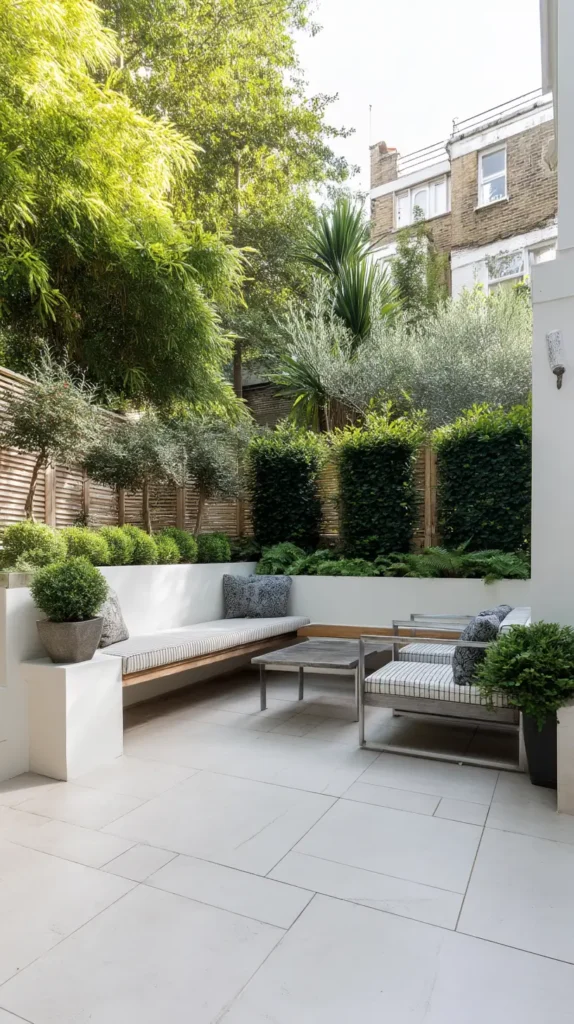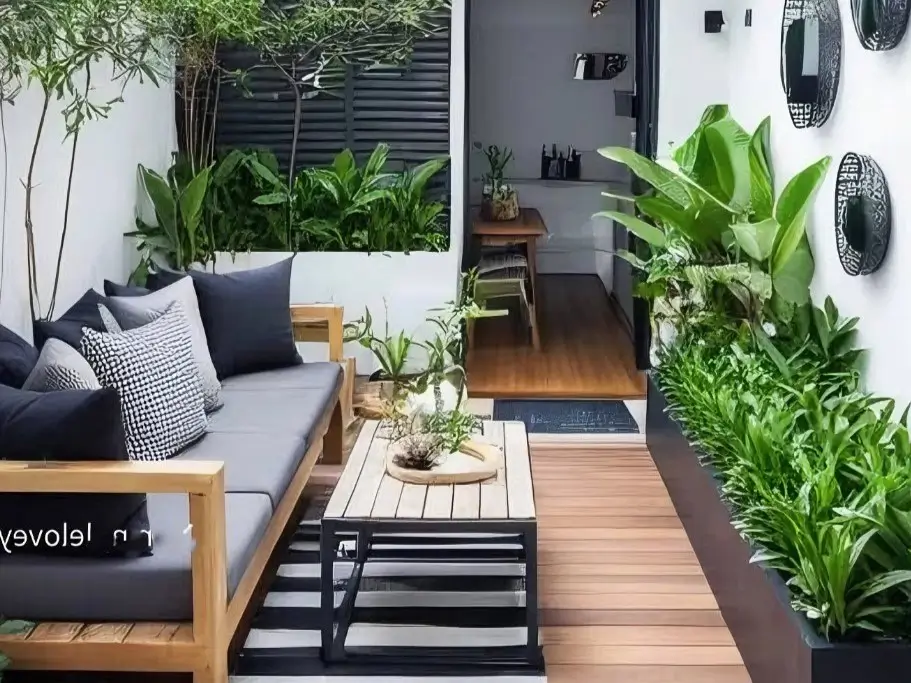Think your small backyard can’t host a beautiful patio? Think again! Limited square footage presents a unique opportunity for creating inviting, functional, and smartly designed outdoor nooks. Transforming even the tiniest patch is possible with the right approach. Explore these 30 inspiring small backyard patio ideas, filled with practical tips and diverse styles, to help you maximize your space and create the charming retreat you desire.
1/30. Create a Formal Path with Geometric Lines

Define your walkway using strong geometric shapes. Sleek, rectangular stepping stones guide the eye through the green space towards the entrance. Precise, low hedges provide structure on one side, while varied plantings add textural interest against the wall. This layered approach maximizes visual appeal in a compact area, feeling both lush and orderly.
2/30. Integrate Seating with Raised Planter Beds

Built-in features maximize utility in tight areas. This design incorporates raised planter beds that flow into a sleek wooden bench, saving valuable floor space while defining the patio edge. Contrasting textures like smooth white render, dark gravel mulch, warm wood, and varied plant forms create significant visual interest and a sophisticated, modern feel.
3/30. Surround with Lush, Layered Greenery

Dense planting transforms a small patio into a private oasis. Utilize various plant heights – from low bedding plants and lush foliage in raised beds to tall, slender trees or bamboo in large pots. This layering technique creates depth, effectively screens views, and fosters a tranquil, enclosed atmosphere perfect for an intimate dining or seating nook.
4/30. Define Pathways with Container Gardens

Container planting offers great flexibility for narrow patios and side yards. Use pots of varying sizes, materials, and styles aligned along a pathway to introduce greenery, color, and texture without needing built-in garden beds. This approach clearly defines the walkway and draws the eye towards a designated destination, like this compact seating zone.
5/30. Maximize Comfort with Built-In Bench Seating

Built-in benches offer generous seating without cluttering limited patio space with multiple chairs. This substantial L-shaped wooden bench clearly defines the lounge area, complemented by the warmth of matching timber deck flooring underfoot. Lush surrounding greenery adds softness, creating an inviting outdoor room perfect for relaxing or entertaining guests comfortably.
6/30. Establish an Outdoor Living Room Feel

Treat your small patio like an extension of your indoor living space for ultimate comfort. Use coordinated outdoor furniture – perhaps a sofa, armchairs, and a coffee table or ottoman – to arrange a dedicated conversation zone. Vertical elements like the bamboo screen backdrop and side planters add enclosure, enhancing the room-like atmosphere.
7/30. Use Modern Planters to Define Dining Zones

Rectangular planter boxes provide clean lines and essential structure, especially effective on smaller patios. Position sleek planters along the edge to create a defined border for a specific zone, like this dining area, separating it visually. Filling them densely with uniform greenery adds lushness, privacy, and a strong design statement.
8/30. Maximize Very Narrow Patio Spaces

Even extremely narrow patios or side passages can become functional outdoor zones. Place slimline furniture, like this compact dining set, directly against a house wall to maintain a clear central pathway. Draw the eye upward and enhance the sense of space with tall, slender plants in pots or narrow beds.
9/30. Zone with Flooring and Add Wall Art

Visually separate functional areas within your small patio by using different flooring materials. Here, warm wood decking clearly designates the lounge seating zone from the surrounding light grey paving. Enhance this ‘outdoor room’ concept further with stylish accessories like a patterned outdoor rug and unique wall art pieces.
10/30. Play with Bold Color and Material Contrasts

Create striking visual impact even in small areas using strong contrasts. Pairing light-colored pavers or gravel underfoot with bold, dark dining furniture immediately establishes a sophisticated, modern aesthetic. Introducing warm wood elements via benches or fencing adds texture and prevents the scheme from feeling too stark.
11/30. Add Formal Structure with Topiaries

Introduce touches of formal garden style for structure, even within confined patios. Potted topiary trees, placed symmetrically here flanking built-in bench seating, add an element of timeless sophistication. The space-saving bench maximizes seating potential along the edge, while warm wooden decking further defines this intimate dining nook.
12/30. Cultivate Privacy with Living Walls

Tall, dense hedges function as beautiful ‘living walls’, offering unparalleled natural privacy and creating a truly immersive garden experience, even in narrow side yards. This technique effectively transforms a simple passage into a secluded green corridor. Placing uncomplicated seating directly within encourages casual enjoyment surrounded by verdant growth.
13/30. Soften Pathways with Round Stepping Stones

Choose large, round or irregular stepping stones for a softer, more naturalistic pathway compared to formal rectangular pavers. Spacing them generously within a lawn or groundcover like this creates an inviting, less rigid feel. This approach complements lush, relaxed planting schemes and integrates beautifully into gardens with mature trees.
14/30. Combine Long Benches with Green Walls

Maximize seating capacity efficiently on narrow patios by installing a long built-in bench along one entire wall or boundary. Pairing this highly functional element with a wall covered in lush climbing plants adds vibrant texture and essential softness, transforming a potentially stark boundary into a beautiful living backdrop.
15/30. Channel Relaxed Vibes with Low Furniture

Low-slung furniture, such as daybeds or deep sofas close to the ground, immediately encourages relaxation and imparts a casual, almost bohemian feel to a patio. Pair these comfortable pieces with natural elements like rustic wood coffee tables and surround the area generously with lush, leafy plants like ferns for a laid-back atmosphere.
16/30. Use Symmetry for Calm and Balance

Symmetry brings an instant sense of calm, order, and intentional design to outdoor spaces. Arranging identical furniture pieces, like these facing daybeds or sofas, creates effortless visual balance. Reinforce the serene atmosphere by incorporating plants known for their tranquil qualities, such as bamboo used here as a graceful green backdrop.
17/30. Introduce Rich Natural Textures

Rich natural textures prevent modern, minimalist patios from feeling cold or sterile. Thoughtfully combine elements like chunky wooden furniture frames, organic bamboo screens or fencing, and perhaps a tactile stacked stone feature wall. This layering of varied natural materials creates depth, warmth, and significant visual interest against simple surfaces.
18/30. Screen with Bamboo in Raised Planters

Bamboo planted within contained raised planter boxes offers an excellent natural screening solution, ideal for masking fences or overlooking neighbors. Its characteristically vertical growth habit provides effective height and privacy without demanding excessive horizontal garden space. Position comfortable seating nearby to fully enjoy the secluded, screened-in ambiance created.
19/30. Use Coordinated Planters for Balance

Create visual harmony and balance, especially on long, narrow decks or patios, by using coordinated planters on opposing sides. Employing matching planter styles or colors – like these sleek white containers holding screening bamboo on one side and complementary shrubs on the other – prevents a lopsided feel and enhances cohesion.
20/30. Mount Planters for Greenery at Eye Level

Floating shelves holding pots or dedicated wall-mounted planters cleverly lift greenery entirely off the floor, saving every inch of precious space on narrow patios or decks. Positioning these features at eye level along a boundary wall adds points of interest and life precisely where they can be best appreciated from seating areas.
21/30. Warm Up Walls with Wood Cladding

Extensive wood cladding instantly transforms plain patio boundary walls, adding significant natural warmth, rich texture, and strong architectural character to the space. Combining this beautiful material with subtle integrated lighting features, like the discreet uplighters seen here, further enhances the sophisticated ambiance, perfect for evening enjoyment.
22/30. Design a Well-Lit Sheltered Dining Spot

Overhead structures provide welcome shelter, instantly extending your patio’s usability across different weather conditions. Combining this essential cover with multiple light sources—like subtle recessed downlights plus atmospheric wall sconces—creates a highly functional and inviting ambiance, perfect for dining day or night within this cozy, room-like space.
23/30. Employ Light Pavers for Brightness

Light-colored paving materials reflect sunlight, significantly brightening narrow or shaded patios. Their clean look provides an excellent base for various styles. Here, they complement classic black-framed French doors and traditional wall sconces, creating a timeless yet fresh space enhanced by warm wood seating.
24/30. Make a Statement with a Rustic Bench

Introduce strong character and warmth by featuring a statement bench crafted from chunky, rustic timber. Its substantial presence and pronounced natural texture provide a beautiful, grounding contrast against smooth modern pavers and clean architectural lines. This single element offers ample seating while serving as a compelling focal point.
25/30. Incorporate Formal Topiary and Shrubs

Carefully clipped shrubs and shapely formal topiary specimens inject instant elegance and intentional structure into contemporary patio designs. Arrange neatly pruned spheres or cones in linear planters along pathways, or feature a single statement cloud-pruned tree. These elements pair beautifully with clean architectural lines and geometric paving patterns.
26/30. Highlight with Architectural Feature Planters

Draw the eye and add sophisticated structure using distinct feature planters within your patio’s layout. Combining architectural planting elements, like a formal standard topiary rising elegantly from a clipped hedge base all within one central container, creates an immediate and impressive focal point amidst surrounding geometric paving or lower beds.
27/30. Keep it Clean with Minimalist Planters

Simple, clean-lined forms enhance a minimalist aesthetic, particularly effective in compact spaces. Choose large, unadorned rectangular planter boxes, like these crisp white examples, to stylishly contain greenery without adding visual clutter. Paired with modern furniture featuring sleek profiles, this approach keeps patios feeling open and contemporary.
28/30. Layer Planting Behind Built-In Seating

Raised garden beds thoughtfully situated directly behind built-in benches allow for effective, space-saving layered planting schemes. Position taller, airier shrubs or small trees behind lower, denser hedges or groundcover plants to create appealing visual depth and rich textural interest. This technique also softens hardscape edges beautifully.
29/30. Step Up Style with Tiered Planters

Tiered planter beds cleverly navigate slopes or simply create dynamic multi-level planting opportunities on otherwise flat patios. They introduce significant vertical interest and allow for varied, structured plant displays, like these elegant formal standard trees gracefully rising above lower clipped hedges. Modular furniture adds welcome layout flexibility.
30/30. Introduce Softness with Curved Lines

Move beyond strict geometry by incorporating gentle, curved lines into your small patio design. Flowing, rounded edges on pathways, planter beds, and even lawn areas or decking create a significantly softer, more organic, and naturalistic feel compared to straight lines and right angles. This approach beautifully complements lush planting schemes.
Seeing real-world examples can also spark creativity. For instance, check out how one family documented the charming evolution of their tiny cottage back patio over several years.
No matter the size of your backyard, a well-designed patio can vastly improve your home’s appeal and usability. We hope these 30 diverse small backyard patio ideas have sparked your imagination and provided practical inspiration. With thoughtful planning and creative touches, you can transform even the tiniest plot into a charming outdoor retreat you’ll enjoy for years to come.
FAQs
How can I make my small patio look bigger?
Use light colors for surfaces and furniture to reflect light and create openness. Draw the eye upward with tall, slender plants, vertical gardens, or wall decor. Choose appropriately scaled furniture (not bulky), especially pieces with visible legs. Strategically placed outdoor mirrors can also visually expand the area.
What is the best furniture for a small patio space?
Opt for pieces scaled for compact areas: classic bistro sets, slimline or armless chairs, and backless benches work well. Consider multi-functional items like storage ottomans or nesting tables. Built-in benches are extremely space-efficient, and lightweight materials allow for easy rearrangement as needed.
How can I add privacy to my small patio affordably?
Plant tall, narrow plants like contained bamboo or evergreen shrubs in pots/beds for a cost-effective living screen. Install simple lattice panels or trellises and grow climbing vines. Weather-resistant outdoor curtains offer flexible, inexpensive screening, as do movable freestanding decorative screens.

